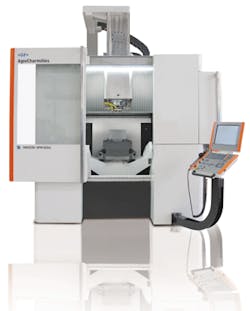MTU Aero Engines, a commercial and military aircraft-engine manufacturer, opened a new “Center of Excellence” recently in Munich, Germany. The excellence is a result, in part at least, of the high-precision machining that the operation is conducting for engine blisks — a production process that relies on high-performance machine tools, like the GF AgieCharmilles Mikron HPM 800U milling machines.
When the Center reaches full capacity, MTU will have 20 milling machines in operation, seven machines with combined milling and turning operations, and eight coordinate measuring machines.
The new operation was established by MTU to address increasing demand for blisks needed to achieve the high-compression required in new families of turbofan engines, including Pratt & Whitney’s PW1000G family and Europrop International’s TP400-D6. The former is high-bypass turbofan engine used to power regional jets like the Bombardier C Series and Embraer’ssecond generation E-Jets; it’s also offers as an option on the forthcoming Airbus A320neo. The latter engine powers the Airbus A4000M, a military air-transport jet.
Blisks are unitary components of turbine engines, consisting of a rotor disk and blades. They’re also referred to as “integrally bladed rotors,” and because they are produced in very hard materials — e.g., titanium, heat-resistant superalloys — and consist of highly complex geometries, blisks present numerous challenges for machinists. Increasingly, these challenges can be address only with advanced machine tool technology.
The Center will raise MTU’s production volume from 600 blisks per year to 3,500 per year by 2016. It can accommodate up to 24 Mikron milling machines as part of an automated process workflow system.
With its solid and sturdy, but compact, design and large work envelope, the Mikron HPM 800U machine is well suited to blisk manufacturing that is efficient, as well as precision-oriented. Its dynamic and economical milling performance is the result of high-power operating mechanisms on the X, Y and Z axes, and direct operating mechanisms on the circular and swiveling axes.
The machine’s maximum X-Y traverse paths are 31.5 in. each direction, with a Z-axis that provides 27.6 in. clearance between the table surface and spindle nose. The Mikron HPM 800U can machine workpieces of up to 31.5 in. in diameter and 23.6 in. high on five sides using tools up to 3.9 in. in length.
The HPM 800U’s Step-Tec spindle provides high performance, even in applications such as large steel drilling with high-torque requirements. Inline motor spindle options include a 20,000-rpm version for general machining, or 28,000-rpm version for machining with small tools.
Both options feature the HSK-A63 interface and are perfectly suited to complex open-die surfaces or machining basic materials. The 28,000-rpm spindle uses CoolCore, a water-cooled rotor shaft, to maintain thermal stability and maximize accuracy.
According to Gisbert Ledvon, director of business development for GF AgieCharmilles in North America, aerospace manufacturing has been a expertise of GF AgieCharmilles for a long time. “We take a lot of pride in how MTU relies on our Mikron HPM 800U machines to easily meet their high precision needs and stringent blisk manufacturing requirements,” he offered.









